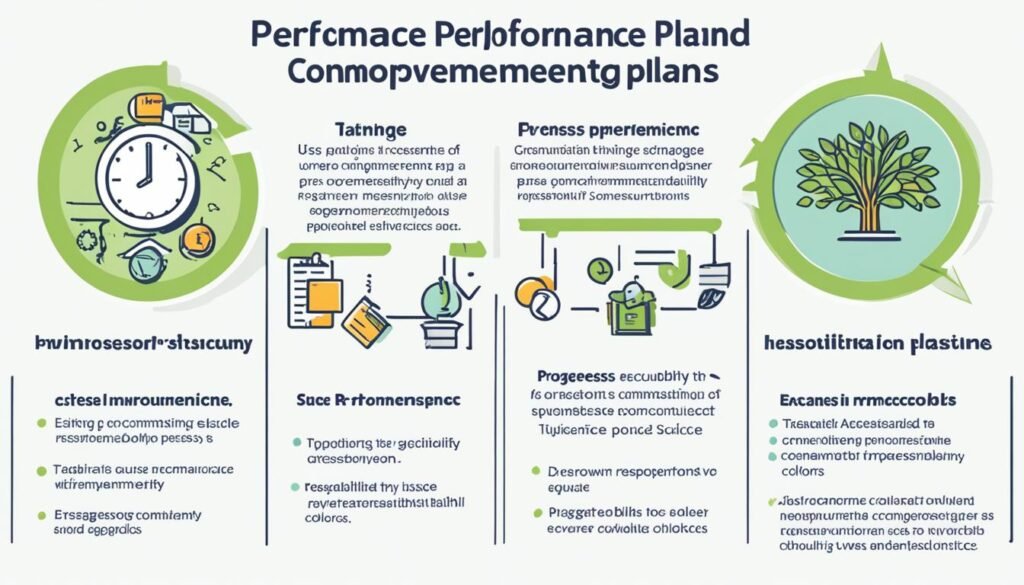Did you know that in 2020, the employee turnover rate was a whopping 44.3% across all industries1? Replacing employees can cost between 50% to 60% of their yearly salary1. This shows how vital it is to manage hiring and firing well. It’s key for any business, big or small, to have the best practices for these HR tasks.
This guide will cover the key steps for hiring and firing employees the right way. We’ll talk about making clear policies, setting expectations during onboarding, and documenting performance issues. You’ll get the tools and advice you need to handle these tricky HR situations with ease.
Key Takeaways
- Understand the high costs associated with employee turnover and the importance of effective hiring and termination practices.
- Establish clear policies and expectations to set employees up for success from the start.
- Thoroughly document performance issues and improvement plans to support termination decisions.
- Ensure termination procedures are conducted with compassion and in compliance with relevant employment laws.
- Maintain consistent hiring and termination practices to avoid legal risks and manage employee morale.
Establish Clear Policies and Expectations
It’s key to have clear workplace policies and set the right expectations from the start. This helps any organization do well2. Make sure to set clear job expectations for new hires to avoid ending up in tough spots3. Having fair work rules and policies makes it clear what employees should do.
Communicate Job Requirements During Onboarding
New hires need to understand their job well, including what they need to do and what the company expects3. This clears up any confusion and helps them do well. Giving regular feedback on how they’re doing helps them get even better.
Review Workplace Policies Regularly
It’s vital to check in with employees on workplace policies often3. This makes sure everyone knows what the company values and needs. It keeps the workplace fair and consistent.

“Clear communication of job expectations and workplace policies is essential for employee success and retention.”
Document Performance Issues and Improvement Plans
Dealing with employee performance problems needs a careful and documented strategy. When an employee doesn’t meet expectations, it’s key to list the exact issues and set a clear plan for improvement4. This lets the employee fix the issues and keeps a clear record for any future decisions, like termination5.
Provide Training and Development Opportunities
Along with noting performance problems, employers should give training and development chances to boost employees’ skills and value to the company4. Studies show that ongoing coaching and growth can raise employee productivity by 25-30% over time5. Investing in employee growth helps companies reach their full potential and build a more engaged and skilled team.
| Company | Number of Employees |
|---|---|
| Numeric.io | 20 |
| CleanItSupply.com | over 100 |
| Directorie | 22 |
It’s wise to have regular performance talks, more often than just once a year4. Also, getting legal advice is smart before firing an employee, especially if they’ve been doing well and are paid like top performers4.
“Overwhelmingly, social media posts of employees being fired are in response to a feeling of surprise.”4
To be fair and give chances for improvement, employers should keep records of poor performance and set clear goals4. Being open, respectful, and supportive during firings can lessen the risks of legal action or social media backlash5.

By using a structured way to tackle performance issues and offering training, companies can build a culture of accountability, growth, and respect. This helps both the employees and the business succeed and stay strong45.
Termination Procedures and Best Practices
When deciding to let an employee go, focus on facts, not feelings or biases6. Before terminating, employers often review expectations, talk openly, coach, set goals, and use performance improvement plans (PIPs)6. It’s important to document everything, from disciplinary actions to the exit meeting6.
Make Termination Decisions Based on Facts
Termination can happen for many reasons, like poor performance or breaking rules6. Some jobs can be ended at any time, without a specific reason, known as at-will employment6. It’s key to document any issues during the termination process6. Performance improvement plans (PIPs) are agreements to help fix performance problems6.
Document the Termination Process
A termination letter should state the reason, last day, and details on benefits, pay, and equipment6. It’s important to wrap up exit paperwork and hand over projects6. Tell the employee about their benefits, pay, and how to return equipment, and consider an exit interview6. Make sure they don’t have access to the workplace anymore6.
Conduct Termination Meetings with Compassion and Respect
Be kind and clear during the termination meeting to avoid regret6. Tell other employees about the termination in a legal way6. Being honest and kind during the process helps make it smoother6.
Also, remember state laws on notice periods and how to terminate employees7. In Missouri, employers must pay the final wage if asked within seven days or face extra costs7. Employees over 40 can file charges with the Equal Employment Opportunity Commission and can’t give up this right, affecting severance agreements7.
COBRA lets employers offer health insurance to terminated employees for 18 months, charging them 102% of the premium7. Employers have 30 days to give terminated employees info on unemployment benefits7.
Terminations don’t need reporting unless there’s a child support order7. Employees must return company items like laptops and keys right away, with the option to send a letter7. Employers can take back company property from an employee’s last paycheck, under certain rules7.
Legal Considerations and Compliance
As an employer, knowing and following employment laws is key when firing an employee. You must stick to federal, state, and local rules about final pay, unused PTO, severance, COBRA, and reporting8. Not following the law can lead to expensive lawsuits and claims of wrongful termination8.
Understand Relevant Employment Laws
It’s vital to know and follow employment laws when hiring and firing workers. You need to understand minimum wage and overtime laws, anti-discrimination laws, and rules about working hours, benefits, and leave9. Keeping accurate records of contracts and pay is also a must to meet legal standards9.
Adding things like arbitration or mediation in contracts can help solve disputes faster than going to court9. Also, non-compete agreements and confidentiality clauses can protect your company when employees leave9.
When firing someone, contracts should say how and why an employee can be let go, including notice and severance, if needed9. How long confidentiality rules last should be clear, often going past the firing date to protect company secrets9.
Legal rules for firing differ a lot around the world and in different places. In the UK, workers get a minimum 1-week notice, no matter how long they’ve worked, and employers must give a notice that can be from 1 week to 12 weeks based on the employee’s time with the company10. The US usually has an “at-will” job system, meaning employers can fire anyone anytime, with or without notice, unless there’s a contract10.
Employers also need to know the rules for voluntary termination, like quitting or ending a fixed-term contract, and medical termination. This ensures they follow laws like the Americans with Disabilities Act (ADA)10.
| Compliance Requirement | Key Considerations |
|---|---|
| Minimum Wage and Overtime | Ensure compensation meets or exceeds minimum wage requirements and adhere to overtime laws9. |
| Anti-Discrimination Laws | Avoid discriminatory language or practices and provide equal employment opportunities9. |
| Working Hours Requirements | Comply with laws regarding working hours, break times, and meal periods9. |
| Benefits and Leave Laws | Understand laws governing employee benefits, including health insurance and leave entitlements9. |
| Record-Keeping | Maintain accurate records of employment contracts and payroll information9. |
By keeping up with employment laws, legal compliance, and best practices, employers can handle hiring and firing workers well. This helps avoid legal problems and expensive disputes89.
Best practices for hiring and terminating employees
It’s key to have consistent hiring and firing rules to prevent bias claims in the workplace11. Employers should make sure firing decisions match past standards. Any changes must be clearly recorded11.
Maintain Consistent Hiring and Termination Practices
When hiring, set clear job needs and share them with new hires11. This makes sure everyone knows what’s expected. When firing, the process should be fair and based on work performance.
Manage Employee Morale After a Termination
After firing someone, talk to the team to keep morale up and clear up any worries11. It’s best to have the firing talk in person, not over phone, text, or email12. Having another person there can help support the person being fired and act as a witness11.
Employers need to know the laws about work, as they change with the state, industry, and company size11. By sticking to best practices and consistent rules, employers can be fair and kind when hiring and firing. This helps keep the team’s morale up.
Conclusion
It’s key to know the best ways to hire and fire employees to keep a good work atmosphere and avoid legal trouble13. Firing someone is hard, but doing it right makes it fair and kind14. This means clearly telling new hires what’s expected, checking in on work rules often, and keeping track of any performance issues14.
When you have to fire someone, make sure it’s for real reasons, keep records, and talk to them with care and respect13. It’s also important to know the latest laws on work and have the same rules for hiring and firing to dodge legal issues1415. A smart and kind way of hiring and firing helps keep a good work culture, keeps the best workers, and handles these tough times well.
To do well in hiring and firing, have clear rules, be open, and treat everyone with respect1314. By doing things right, employers can make these processes work for everyone, creating a positive and productive place to work.
FAQ
What are the key best practices for hiring and terminating employees?
How can employers communicate job requirements and workplace policies to new hires?
What should employers do if an employee is underperforming?
What are the best practices for terminating an employee?
What legal considerations do employers need to be aware of when terminating an employee?
How can employers maintain consistent hiring and termination practices?
Source Links
- https://www.hrresolutions.com/blog/best-practices-for-terminating-an-employee/
- https://www.shrm.org/topics-tools/news/hr-magazine/termination-tips-hr-practitioners
- https://www.wolterskluwer.com/en/expert-insights/employee-termination-procedures-policies
- https://www.shrm.org/topics-tools/news/employee-relations/firing-for-poor-performance-best-practices
- https://www.insperity.com/blog/6-steps-you-need-to-take-before-terminating-an-employee-for-poor-performance/
- https://www.pipefy.com/blog/termination-process/
- https://tandemhr.com/best-practices-employee-termination/
- https://www.jibble.io/labor-laws/us-federal-labor-laws/firing-guide
- https://www.proalt.com/key-considerations-for-drafting-effective-legal-employment-contracts/
- https://www.shiftbase.com/glossary/termination-of-employment
- https://www.hrresolutions.com/blog/best-practices-for-terminating-an-employee-2/
- https://www.trinet.com/insights/what-to-say-when-terminating-an-employee-with-sample-scripts
- https://hiring.monster.com/resources/workforce-management/leadership-management-skills/employee-termination-tips/
- https://floowitalent.com/small-business-employee-termination-guide/
- https://njbia.org/wp-content/uploads/2017/03/ebook_le_successfulemploymentterminationstrategies-C1.pdf

